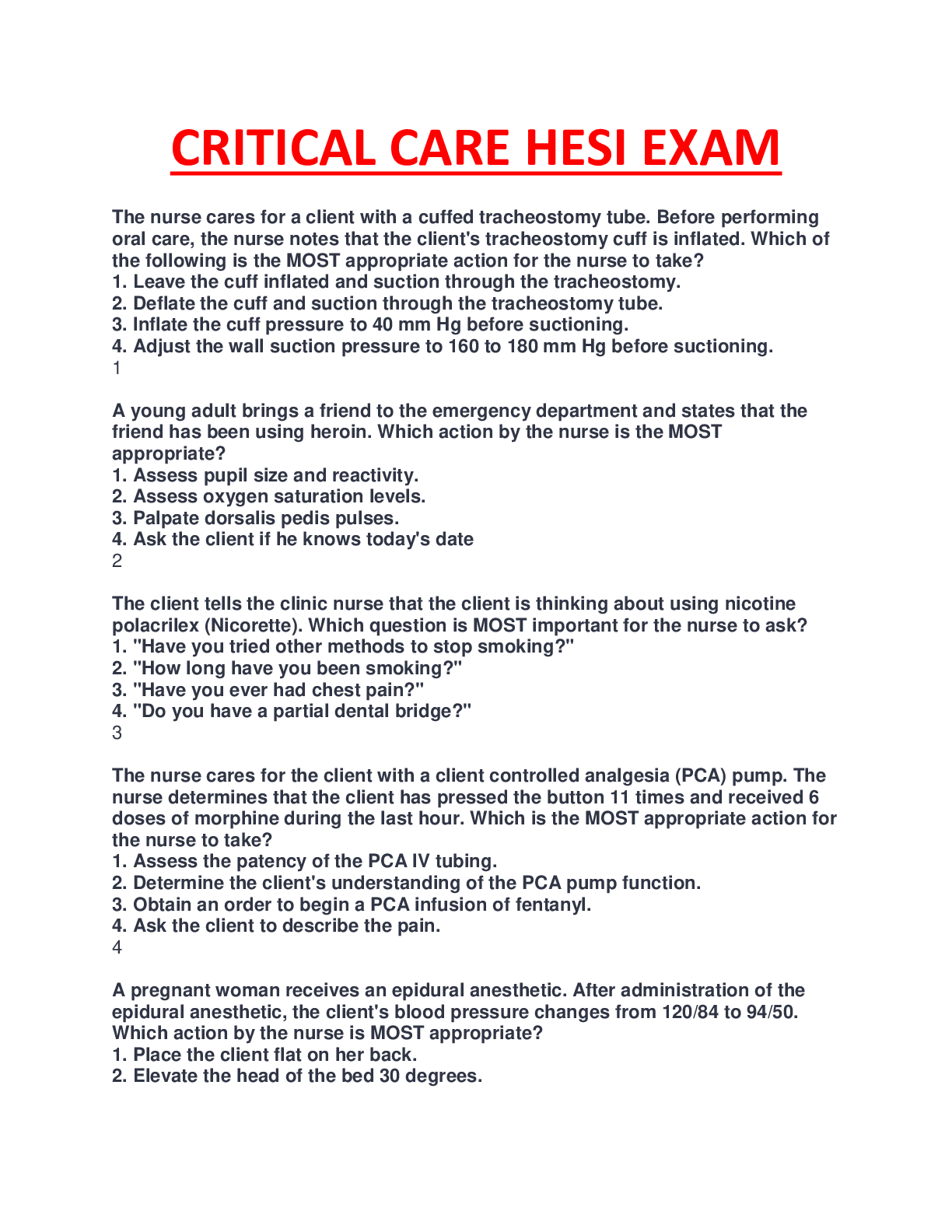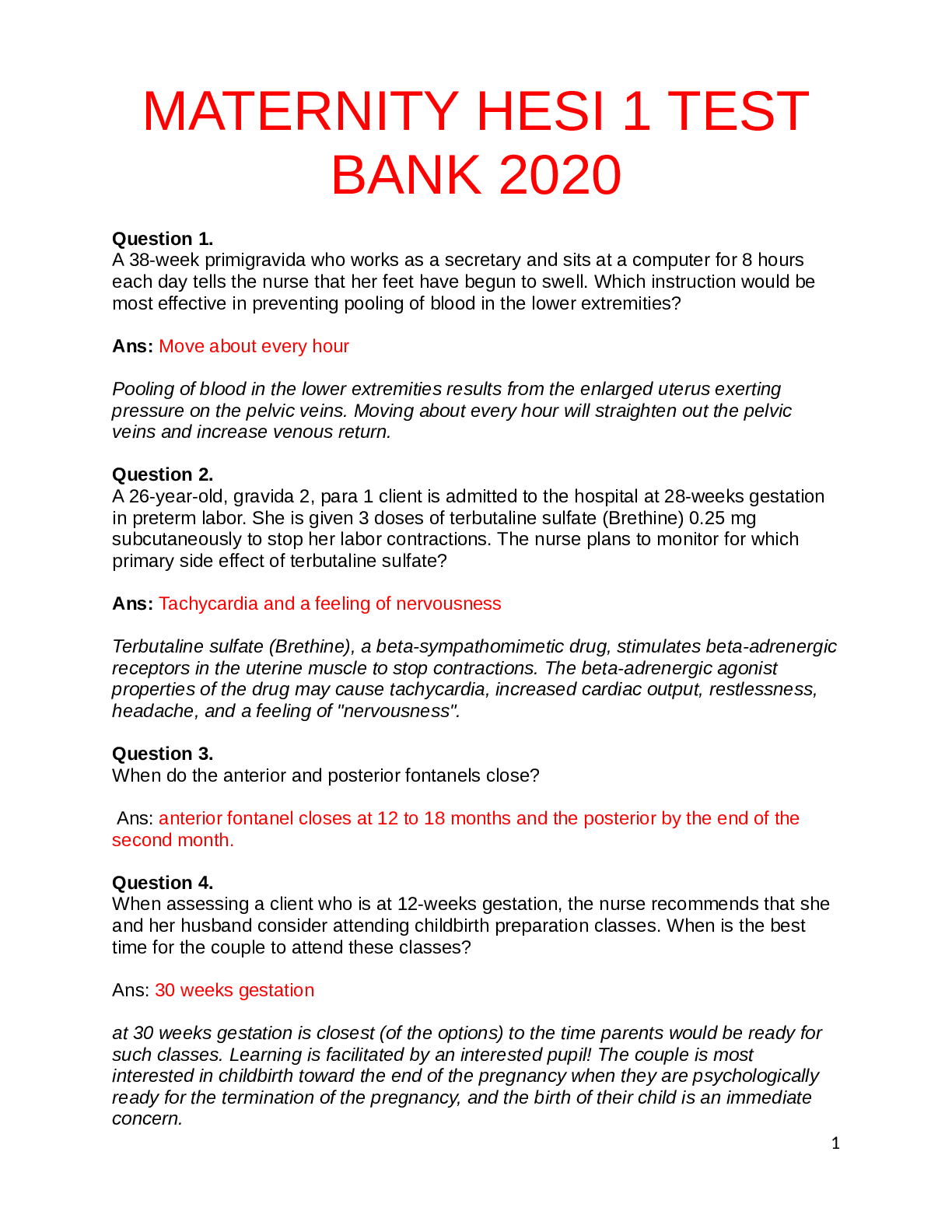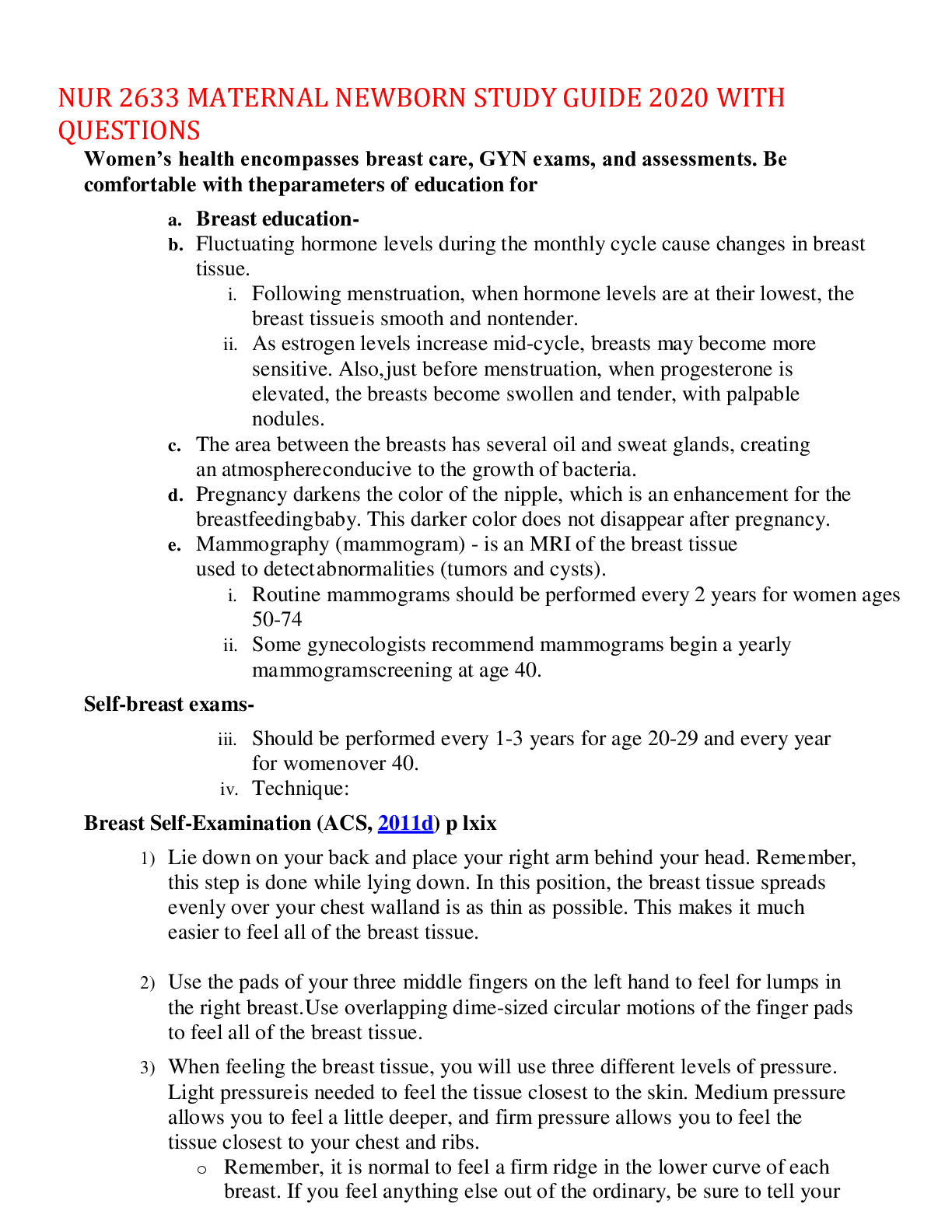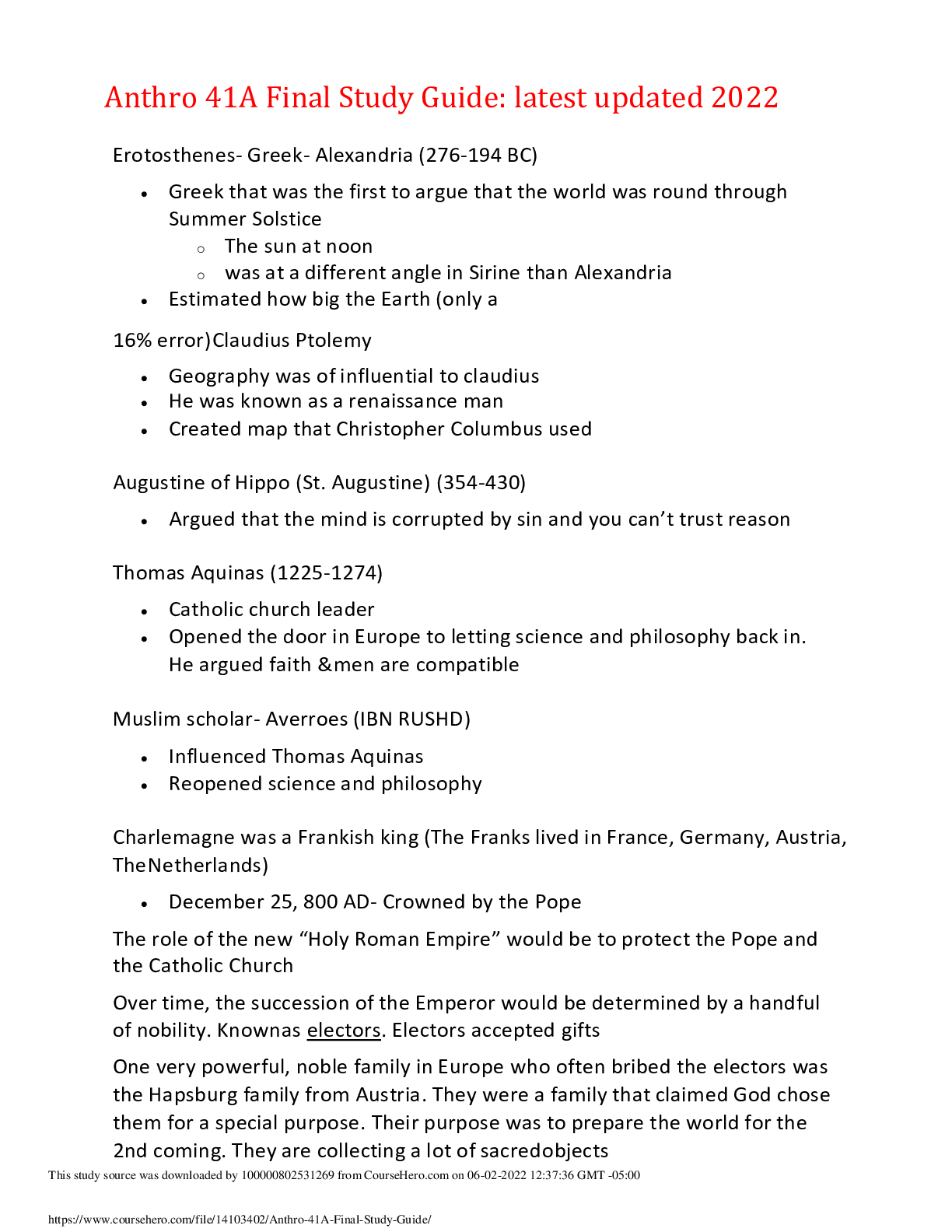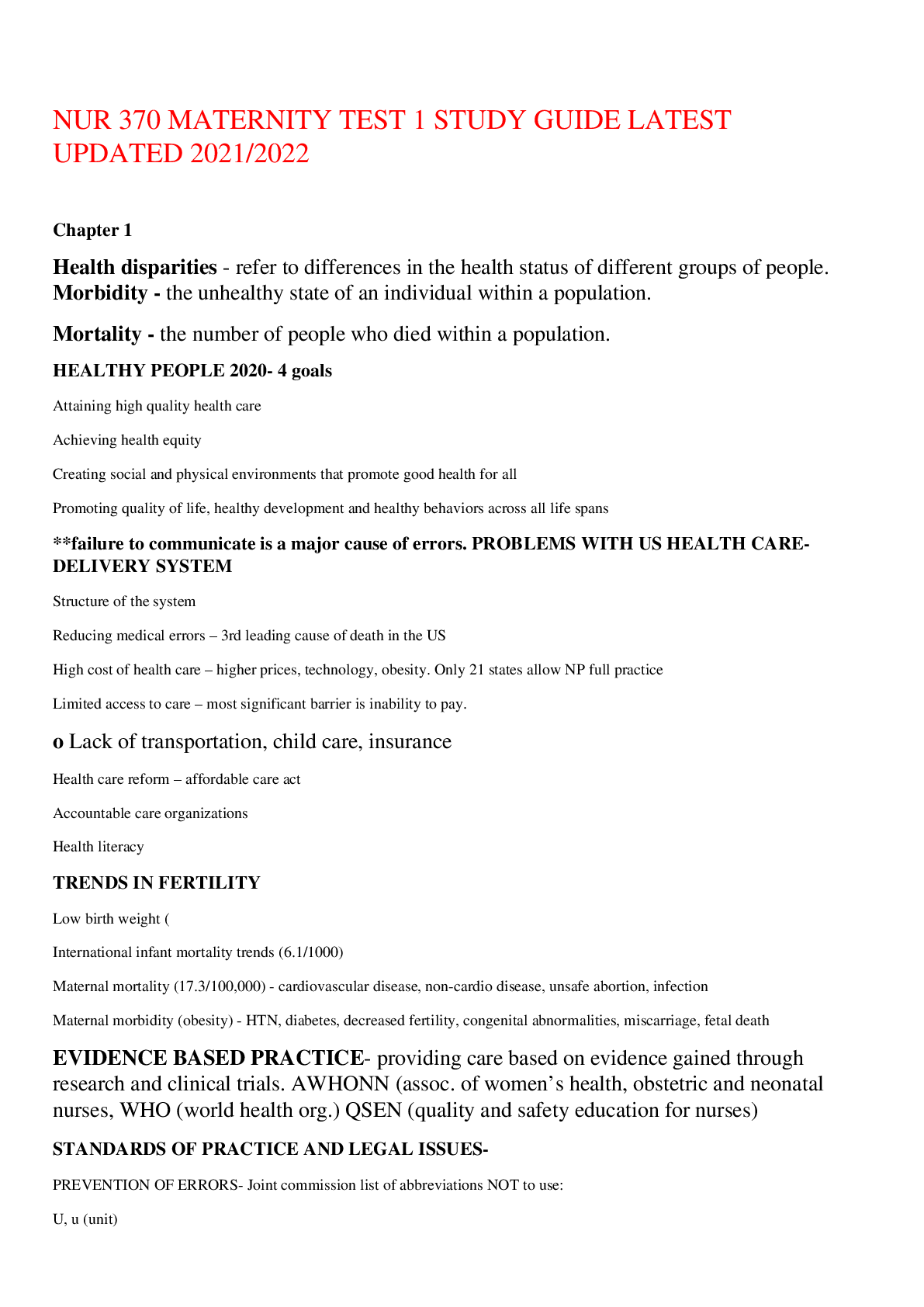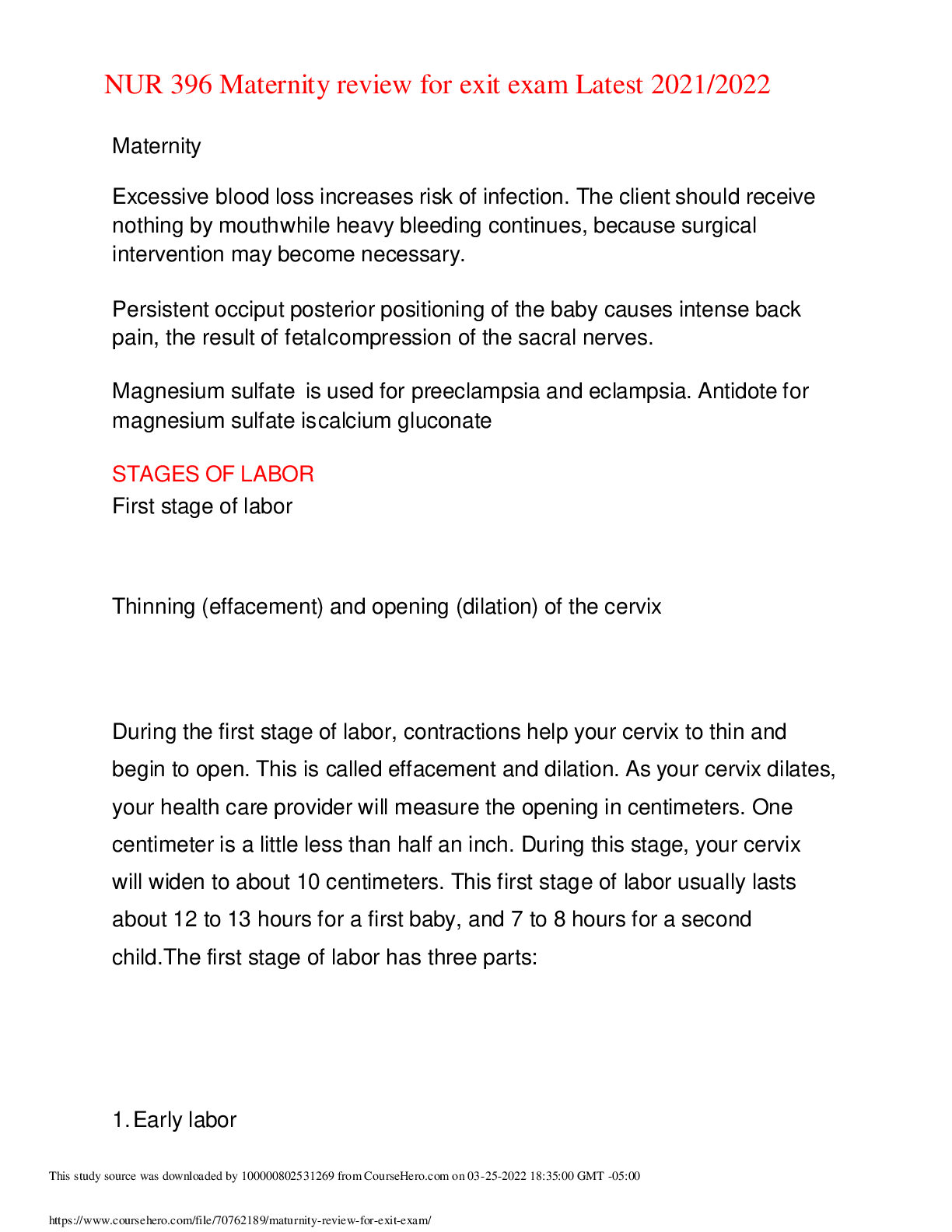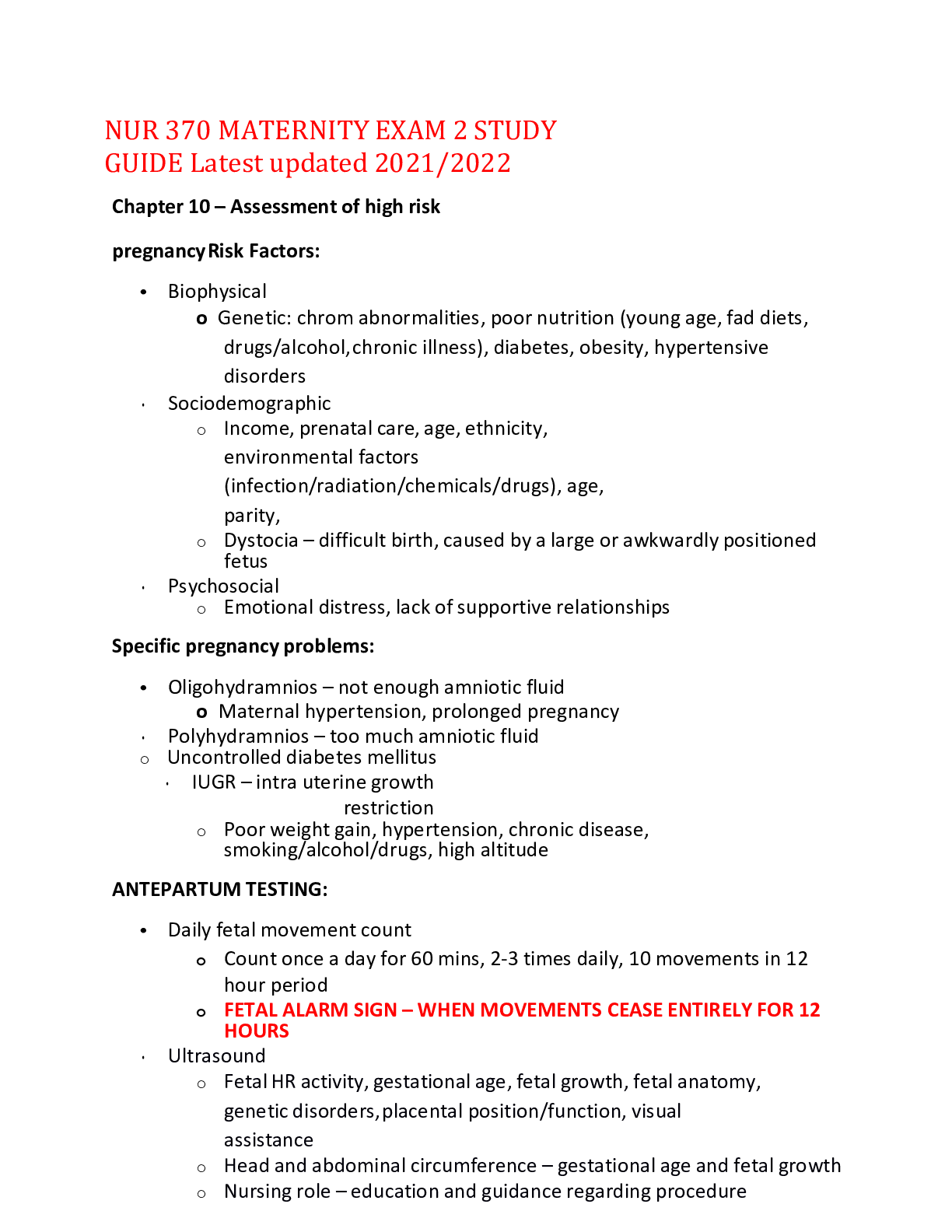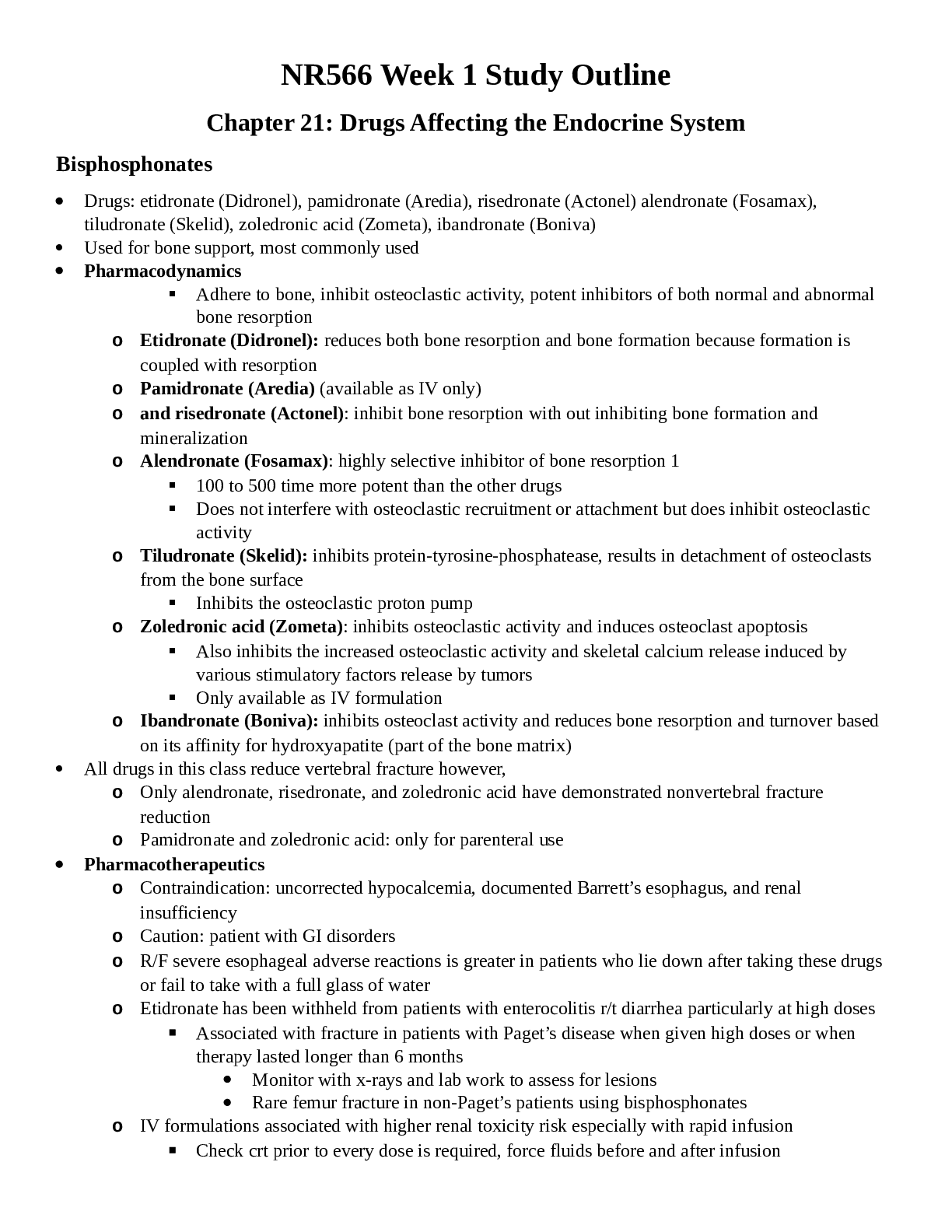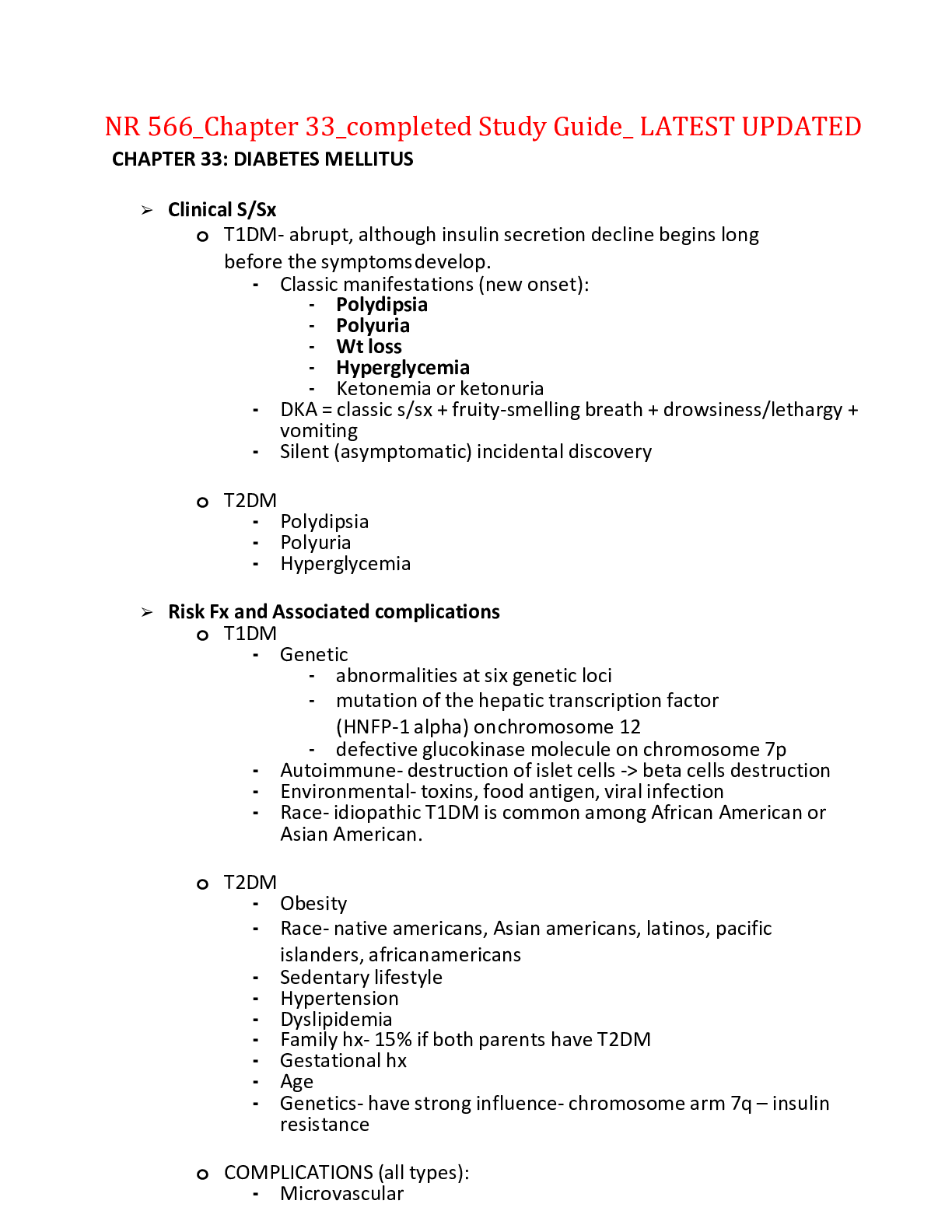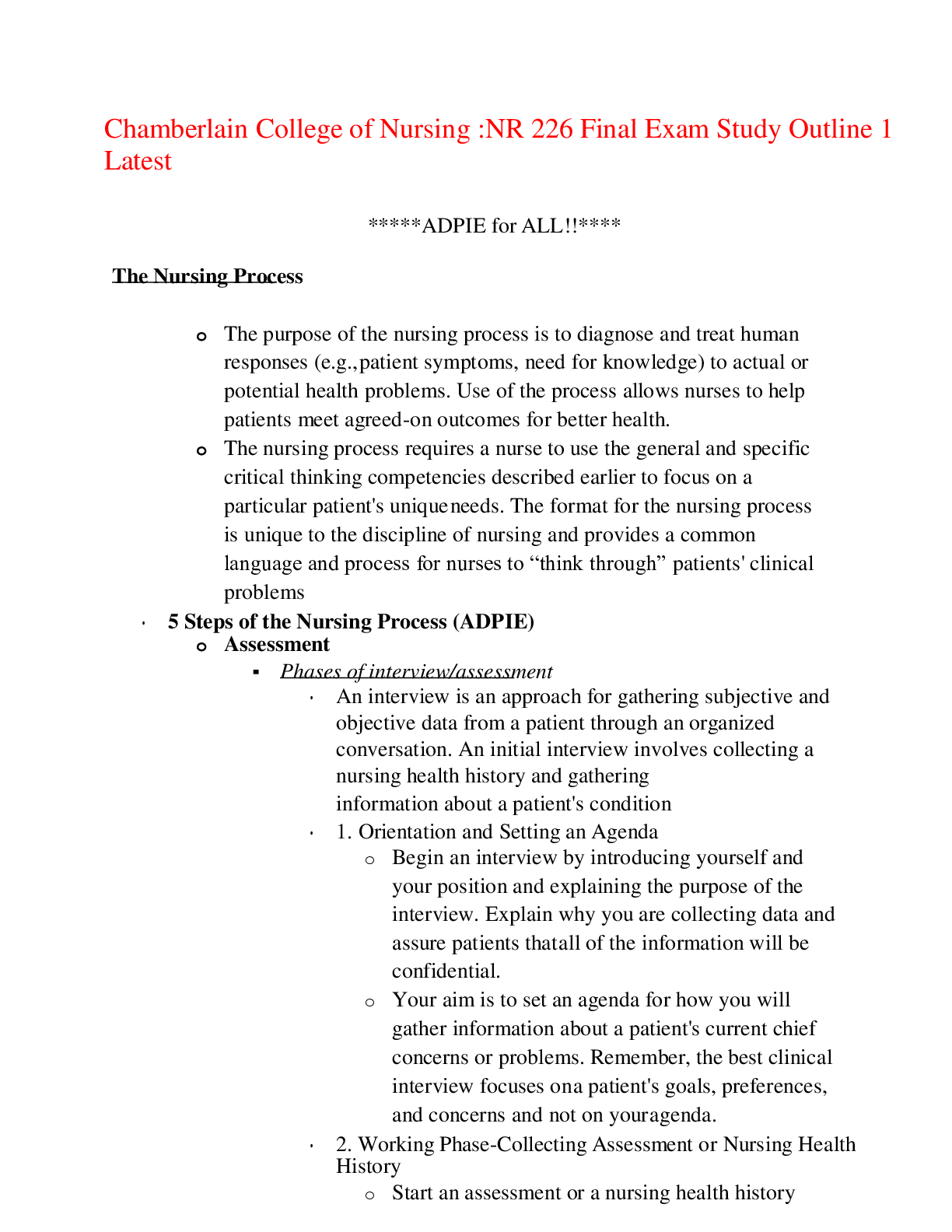*NURSING > STUDY GUIDE > Rasmussen College: NUR2356/MDC1 Study Guide FINAL Exam_ LATEST 2021/2022 ,100% CORRECT (All)
Rasmussen College: NUR2356/MDC1 Study Guide FINAL Exam_ LATEST 2021/2022 ,100% CORRECT
Document Content and Description Below
Rasmussen College: NUR2356/MDC1 Study Guide FINAL Exam_ LATEST 2021/2022 MDC1 Final exam TOTAL questions- #150= 300 points Module 10 -#30 1. Scleroderma a. AKA systemic sclerosis b. Rare au... toimmune connective tissue disorder c. Abnormal thickening of the skin d. Secondary Raynaud’s phenomenon can occur 2. Lupus a. 2 classifications: i. Discoid (affects the skin) ii. Systemic (causes major body organs to fail) (has remission and exacerbations, causes direct damage and causes vasculitis which deprives organ of blood and oxygen) (Butterfly rash across the nose, nephritis, pericarditis, Raynaud’s phenomenon) b. Lupus nephritis is the leading cause of death for lupus because of the damage done to the kidneys 3. Rheumatoid arthritis a. Autoimmune inflammatory systemic disease of the synovial joints. CD4+ helper cells stimulate release of cytokine release, stimulates neutrophils to break down cartilage. Steroids 4. CREST Syndrome a. Multisystem connective tissue disorder b. Calcinosis c. Raynaud’s phenomenon d. Esophageal dysfunction e. Sclerodactyly (thickening and tightening of skin of fingers and hands) f. Telangiectasia (dilation of capillaries, red marks on surface on skin) 5. Reynaud’s a. Think of Elsa from Frozen (cold hands and feet); can’t get a pulse Ox because fingers are too cold b. Risk factors for primary Reynaud’s: sex, age, climate, family history c. Secondary Reynaud’s: happens as a result of another illness 6. Osteoarthritis a. Most common type of arthritis in the U.S. b. Results in bone rubbing against bone in the joint space causing joint pain and stiffness leading to decreased mobility and muscle atrophy c. Risk Factors: aging, genetic factor, obesity, trauma, occupation d. Treatments: NSAIDS, acetaminophen, other analgesics 7. Gout a. Systemic disease where urate crystals deposit in the joints and other body tissues b. Primary: inborn errors of purine metabolism with the end product uric acid c. Secondary gout hyperurcemia caused by another disease or factor d. Risk Factors: obesity, cardiovascular disease, alcohol, chronic kidney failure, starvation/dieting, trauma e. Education: avoid organ (red meats) or shellfish, limit alcohol intake, limit aspirins, and diuretics, remind pt to increase fluid intake f. Treatments: NSAIDs, corticosteroids, main medication= colchicine 8. Fibromyalgia a. Chronic Pain Syndrome b. Widespread musculoskeletal pain w fatigue, sleep, memory and mood issues c. Cause is unknown d. Risk dactors: sex (more prevalent in women than men), family history, more likely to develop if you have osteoarthritis, lupus, RH e. Treatment: none 9. Priority care 10. Patient education Module 9 -#30 1. Infection types a. Opportunistic: infections caused by non-pathogenic microorganisms which becomes pathogenic when the immune system is impaired by an unrelated disease(Think of a person with HIV –chronic stage of a disease- getting a infectious disease like pneumonia b. Pathogenic: 2. Immunity types a. Antibody-mediated immunity-humoral immunity i. Antigen-antibody interactions to neutralize, destroy, or eliminate foreign proteins; antibodies are produced by sensitized B-lymphocytes; the antibodies are produced by the lymphocytes and destroy the invading protein; B-cells are produced in the spleen, lymph nodes, tonsils and mucosa of the intestinal tract b. Cell-mediated immunity-cellular immunity i. Rely on the function of the T-cells as well as the cells known as natural killer cells; natural killer cells are known as CD16+ cells and have a direct effect of non-self-cells without first being sensitized, they also seek and destroy abnormal self-cells such as cancer cells and virally infected body cells 3. Prevention of infection a. Avoid crowds b. Bathe daily with antimicrobial soap c. Wash hands thoroughly d. Avoid raw fruits and vegetables e. Avoid working in the garden or with houseplants f. Monitor for signs and symptoms of infection i. Increase in temperature ii. Purulent drainage iii. Foul-smelling drainage iv. Cloudy urine 4. HIV patient psychosocial a. Depression, suicidal ideas, body dysmorphia 5. AIDS findings of infection a. Fever, fatigue, headache, rash, sore throat, swollen lymph nodes, monitor intake, educate client about medications (if they have any symptoms of TB then they must be quarantined immediately in an air tight room) 6. Sterile field a. Area created by placing sterile drapes around the patient’s surgical site and on the stand that will hold sterile instruments and other items needed during surgery 7. Impaired immune system a. HIV patients, post-op patients, cancer patients 8. Skin protection a. Sunblock, skin moisturizer, skin barriers 9. Antibiotics a. 10. Virulence a. Power of the agent to cause a disease and the ability to damage its host b. Virulence is related more to the frequency with which a pathogen causes disease (degree of communicability) and its ability to invade and damage a host. Can also indicate the severity of the disease 11. Isolation types a. Contact: C-diff, MRSA b. Airborne: think MTV is on the air (Measles, TB, Varicella), N95 c. Droplet: flu, whooping cough, mumps, respiratory illnesses such as COVID-19 12. Vital signs change in infection a. Check every 4 hours b. Everything high (BP, Temp, HR) 13. Patient at risk for infection a. (AKA a susceptible host) (A person at risk because of inadequate defenses against the pathogen) b. Age (older adults) c. Compromised immune system –cancer treatment d. Conditions causing immune deficiency –HIV e. Low socioeconomic classes related to inability to obtain immunizations f. Non-immunized adults g. Clients with substance abuse disorders h. Clients with a genetic risk of decrease or excessive immunity 14. Breaking the chain of infection a. Reduce exposure to pathogens by using aseptic techniques b. Maintain skin integrity and support natural defense systems of the body against infections c. Reduce stress d. Reduce the length of time clients require invasive devices (medical equipment) 15. Infection: agent, host, reservoir, port of entry/exit, transmission a. Agent (bacteria, virus, fungus): an invasion and multiplication of pathogens in the body b. Reservoir: place where the organisms survive and multiply c. Portal of exit: d. Mode of transmission: droplet, airborne, vector, direct contact, indirect contact e. Portal of entry: normal body openings; cut, scrapes and surgical incisions; invasive devices such as IV sites, urinary catheters f. Susceptible host: person who is at risk because of inadequate defenses against the pathogen (age, compromised immune system –cancer treatment, conditions causing immune deficiency –HIV) Module 8 - #30 1. Healing process stages (Primary, secondary, Tertiary) a. Phases of wound healing: i. First intention (Inflammatory)- edges brought together with skin lined up in correct anatomical position ii. Second intention (Proliferative)- requires gradual filling in of dead space with connective tissue iii. Third intention (Maturation)- delayed closure; high risk for infection with resulting scar 2. Wound bed colors (red, yellow, green, grayish milky) 3. Wound bed tissue (slough, granulation, eschar, necrotic a. Slough: yellowish, stringy, soft but not pus b. Granulation: red, moist and shiny c. Eschar: black, leathery and unstageable d. Necrotic: dead, dry, leathery and tissue 4. Pain management a. Non-pharmacological b. Pharmacological 5. Priority care a. Wound assessment b. Prevent ulcers from developing into further stages 6. Pressure injury stages (1-4, Unstageable) a. Stage 1: skin intact, area usually over bony prominence, does not blanch with external pressure, observable pressure-related alterations of intact skin b. Stage 2: skin not intact, partial-thickness skin loss of epidermis or dermis, ulcer is superficial, may appear as abrasion, blister, or shallow crater, bruising is not present c. Stage 3: full-thickness skin loss, subcutaneous tissue and underlying fascia may be damaged or necrotic, bone/tendon/muscle not exposed, may have undermining tunneling d. Stage 4: full-thickness skin loss with exposed or palpable muscle, tendon, or bone, undermining and tunneling common with sinus tracts possible, slough and eschar often present e. Unstageable: full-thickness tissue loss in which the base of the ulcer is covered by slough and/or eschar in the wound bed 7. Post-Surgical complications a. Dehiscence: when the wound comes open b. Evisceration: when the body part comes out (put patient in low fowlers position with knees flexed) 8. Normal skin findings a. Pinkish color (consistent with ethnicity) 9. Pressure injury prevention interventions a. Turn patient every 2 hours b. Encourage patient to turn themselves every 15 mins 10. Nutrition for skin healing a. Protein b. Vitamin A and C c. Zinc d. Fluids 11. Drainage color (sanguineous, serous-sanguineous, purulent, etc.) a. Serous = clear b. Sanguineous = bloody c. Serosanguineous = clearish and bloody d. Purulent = yellowish/green 12. Exudate assessment a. Assessing the drainage (color, consistency, and odor) 13. Cellulitis and what interventions to do a. Cellulitis is a skin infection b. You want to mark it with a pen around the infection so you can monitor if it continues to grow 14. High risk for pressure injury and skin breakdown a. Elderly patients, bed-bound patients, post-op patients 15. Elderly skin changes a. Stretchy, thin, elastic like, age spots 16. Braden Scale a. Used to assess pressure wounds b. Mild risk: 15-18, High: 10-12, Severe: <9 c. Categories are: (each category is out of 4; 4 being rarely, 1 being always) i. Sensory/perception ii. Moisture iii. Activity iv. Mobility v. Nutrition vi. Friction/shear 17. Shearing and Friction a. Dragging patient against the bed when moving then (not lifting) (basically rug-burn) Module 7 -#10 1. Safety (fall prevention, fire, home care safety), 2. Communication, especially with impaired patients 3. Glaucoma (symptoms, signs, education, interventions,) a. Common in African Americans > 40 or all >60; Genetic, corneal thinness, abnormality of optic nerve, damage starts out peripheral and then extends b. Open angle: drainage goes out (90% of cases) foggy vision, mild eye aching, headache, halos around lights, losing peripheral vision c. Closed angle: drainage is blocked, rapid onset, less common d. Secondary glaucoma: related to another eye problem e. Associated glaucoma: related to another disease process f. Non-surgical drug therapy g. Surgical management: laser trabeculoplasty, trabeculectomy 4. Cataracts (symptoms, signs, education, interventions, surgical interventions) a. Opacity of the lens of the eye that lies behind the iris; age related; makes it difficult to see retina, no pain or eye redness b. Risk factors: diabetes, hyperparathyroidism, down syndrome, chronic sunlight exposure, corticosteroids, phenothiazine derivatives, miotic agents c. Surgery will destroy opaque lens by phacoemulsification and suctioned out and replaced by a plastic lens 5. Tests for auditory; test for glaucoma, test for open or closed angle glaucoma a. Auditory: hearing test b. Glaucoma: tonometry c. Open angle glaucoma: gonioscopy (when the test shows it is wide and opened) d. Closed angle glaucoma: gonioscopy (when the test shows it is closed and blocked) Module 6 - #10 1. Assessment when a fall happens a. Check vital signs and neuro 2. Neurovascular assessment a. Pain b. Pulse c. Pallor (skin color) d. Parasthesia (can you feel this?) e. Paralysis (can you move this?) 3. Cast care a. Don’t stick anything inside them (to itch etc.) b. Inspect the cast regularly c. Keep dry; moisture weakens the plaster and damp padding next to the skin can cause irritation 4. Type of fractures a. Incomplete fracture: bone is not completely separated b. Complete fracture: bone is completely separated c. Transverse fracture: break is in a straight line across the bone d. Spiral fracture: the break spirals around the bone; common in a twisting injury e. Oblique fracture: diagonal break across the bone f. Compression fracture: the bone is crushed, causing the broken bone to be wider or flatter in appearance g. Comminuted fracture: the break is in three or more pieces and fragments are present at the fracture site h. Segmental fracture: the same bone is fractured in two places, so there is a “floating” segment of bone Module 5 - #10 1. Crepitus a. Crackling or grating sound caused by bones rubbing against each other; AKA creaky joints b. The production of crepitation in the lungs = rales 2. Osteoporosis a. Bone disease that occurs when the body loses too much bone, makes too little bone, or both. As a result bones become weak and break from a fall or, in serious cases, from sneezing or minor bumps 3. DVT a. When a blood clot (thrombus) forms in one or more of the deep veins in your body, usually in your legs. 4. Nursing assessment, interventions, evaluation; patient education a. Nursing assessment: the gathering of information about a patient’s physiological, psychological, sociological, and spiritual status b. Interventions: the implementation of the nursing care plan c. Evaluation: final step in the nursing process; the step the reviews everything that has been done and review if the desired outcome was reached or not, if not figure out a new care plan to reach the desired outcome d. Patient education: empowers patients to improve their health status; when patients are involved in their care they are more likely to engage in interventions that may increase their chances for positive outcomes Module 4- #10 1. Promotion of independence a. Emphasize partnership, use motivational interviewing, provide useful information, make it easy, address barriers 2. Benefits of activity a. Reduce the risk of a heart attack, manage weight, lowers blood cholesterol levels, lowers the risk of type 2 diabetes/some cancers, helps lower blood pressure, strengthens bones/muscles/joints, lowers risk of osteoporosis, lowers the risk of falls 3. Posture a. Places the spine in a neutral (resting) position; allows the bones to be aligned, reduces stress and fatigue & muscles, joints, and ligaments can work efficiently 4. Risk of immobility a. Decrease in depth of respiration, pooling of secretions in the airways, decrease ability to effectively cough, increases the workload of the heart, promotes venous stasis, risk of thrombus formation, drops the metabolic rate, decreased appetite, weight loss, bone loss from calcium reabsorption, external pressure leads to compressed capillaries in the skin, constipation, paralytic ileus, kidney stone formation, stagnant urine leading to increase UTIs, isolation, mood change, depression, anxiety Module 3- #5 1. Vital signs a. Temperature i. 96.4-99.5 F ii. Can be taken orally, axillary, rectally, temporal artery, tympanic b. Pulse i. 60-100 beats per minute ii. Pulse points are carotid, radial, femoral, popliteal, posterior tibial, and dorsalis pedis arteries c. Blood Pressure i. 120/80 ii. Appropriate cuff size (you want the bladder of the cuff to be 80% of the arm circumference) d. Respiration i. 12-20 breaths per minute e. Pain 2. Safety priority a. Protection from harm, provide adequate shelter, minimized or remove any fear/anxiety, and minimize errors in care 3. Never events a. Serious injuries or death to a patient that should have never happened in a hospital b. Examples: air embolism, wrong transfusions, falls, trauma or injuries, DVT or PE after knee surgery, CAUTIs, CLABSIs, HAPIs, etc. 4. Fall prevention a. Non-slip socks, rubber soled shoes, lighting up walking areas, avoid throw rugs, keep walking areas free of clutter, remove stray cords Module 2- #5 1. Therapeutic response a. Achieving an improvement in the patient’s health; helps gain knowledge, information, work through issues, concerns, treatment and care plans 2. Culture importance in healthcare a. Socially transmitted behaviors, arts, beliefs, values, customs, life ways and other characteristics that guide decision making b. 3 Major Health Beliefs i. Scientific (hospitals, clinics, medications, etc.) ii. Magico-Religious = “alternative or indigenous” (supernatural forces of healing, rituals) iii. Holistic = need for harmony and balance of the body with nature (yoga, mediation, etc.) 3. Therapeutic communication techniques a. Express interest, concern, caring perception, provide and obtain healthcare information; active listening b. Communication phases i. Pre-interaction (collection of data) ii. Orientation (establishes rapport and trust by using nonverbal and verbal communication) iii. Working (maintain mutual respect, honesty, clarify feelings and express concerns) (Active listening is very important in this phase) iv. Termination (reviews and summarizes the shared information successfully 4. Barriers of communication a. Changing the subject b. Expressing approval/disapproval c. Asking too many questions d. Offering advice e. Providing false reassurance f. Stereotyping g. Using patronizing language Module 1 - #5 1. Pain types a. Cutaneous pain: arises from burning your skin like on a hot iron or from touching a hot pan on the stove b. Visceral pain: caused from deep internal disorders such as menstrual cramps, labor pains, or GI infections c. Deep Somatic pain: originates from the ligaments, tendons, nerves, blood vessels and bones (ex: would be a fracture or a sprain) d. Radiating pain: starts at an origin but extends to other locations (ex: pain from a sore throat might extend to ears and head) e. Referred pain: occurs in an area distant from the origin (ex: pain from a heart attack might be felt in the left arm or jaw) f. Phantom pain: pain that is perceived from an area that has been surgically or traumatically removed (ex: pain from an amputated limb) g. Neuropathic pain: results from an injury of one or more nerves h. Acute pain: short duration, rapid onset, and associated with some kind of injury i. Chronic pain: last 6 months or longer and interferes with ADLs 2. Assessment of pain a. Subjective data b. Objective data c. Pain rating d. Location, intensity, duration, description, how it impacts ADLs e. Set goals for comfort and function/recovery/quality of life 3. Safety Dosage and Calculation -#5 1. Conversion- weight, temp, common equivalents 2. I & O’s [Show More]
Last updated: 1 year ago
Preview 1 out of 15 pages
Instant download

Buy this document to get the full access instantly
Instant Download Access after purchase
Add to cartInstant download
Reviews( 0 )
Document information
Connected school, study & course
About the document
Uploaded On
Feb 11, 2022
Number of pages
15
Written in
Additional information
This document has been written for:
Uploaded
Feb 11, 2022
Downloads
0
Views
72

.png)
